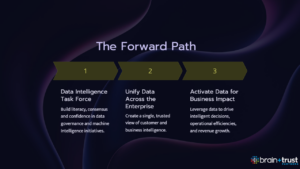This fall, we are celebrating the one-year mark of Brain+Trust Partners being open for operations. It has been a kinetic launch, and we will forever have a “startup” attitude, leaning into a journey that each day has seemingly only just begun. After all, the rate of change in human behavior at the hands of technology means that little about business today may be linearly planned or executed. Still, as thrilling as starting something new is, we know that what is past is prologue and that we have as much to gain from observing our past lessons and experiences as we confidently charge forward into the future.
Way Back in 2007
A decade ago, I invested a week at the GamePlan (like long-lost treasure, I found one of our old sites from 2009!) conference table alongside Keith Dudley, Cierra Savatgy-King, Christian Zdebel and others to map out the ideal marketing experience or customer journey (illustrated above), for acquiring new customers and engaging “known” customers. After producing global campaigns for AMD, Bacardi USA, Dell and others, we recognized that new behaviors were developing through the way people were capturing moments at events, first empowered to do so with Blackberry smartphones and other mobile devices capable of photography and instant recording of the experience around them.
Like magic, we had to wait only a few days after a trade show, concert, sports event or in-store promotion to manually monitor through Google how such user-generated content had been shared on Friendster or uploaded to YouTube (They had to go home, then connect the phone via cable to the computer…). Then, we would reconcile profile names from those social networks and phone numbers captured via SMS promotions with existing customer datasets (catalog lists, email databases, and other spreadsheet-driven lists). Matching that someone who attended an event AND opened last month’s e-newsletter AND/THEN had clicked through to a point of purchase, we could demonstrate value in the event AND make decisions on what to do next: Send another email? Use the same messaging? Employ the same tactics at the next tour stop?
A few months later in 2008, we suddenly had more opportunities to track customers and fans from live experiences to their newly established Facebook profiles. We would apply game theory (Markov chains) to execute marketing campaigns that led consumers along an episodic trail of physical offline experiences and web content that ultimately led to purchase. This mix of experiential media soon became known as “alternative reality” where a brand could engage an audience both offline and online to influence store or web traffic. It was then, in the early days for social media and smartphone use, that I knew there was no easy way to capture data and derive insights to drive the next move and further marketing success.
Fast Forward to 2017
Over the past twelve months, we at Brain+Trust Partners have held as many observations that enlighten our understanding of how humans behave and how brands attempt to capture their attention. There seems to be an application or platform to manage and measure almost anything in marketing, customer care, and general business operations today. We also don’t have to scroll too far down our Twitter or Facebook newsfeeds to realize that society, in general, is more connected, people often believe what they think free of fact, and any moment of the day may be a digital opportunity or challenge to a brand.
What has been troubling, however, is that we have found that companies are still investing in point solutions and “the latest” in virtual reality, chatbots, social and mobile tools without truly knowing the preferences and behavioral tendencies of their customers. We’ve encountered very few brands that are leveraging the ease of integrating systems and unifying customer data to best understand the needs and behavior of current known customers — and, that could vastly improve overall business performance. The Googles, Netflixes and Airbnbs of the world are doing all of this very well and sharing such insights across traditionally disparate operations such as logistics, customer care, marketing and product development.
2018, Onward
Even with concern for any current technology disarray we have witnessed, I have confidence for the future. With more than a decade passed that I’ve been transforming how brands interact with customers, I believe 2018 will be different. Very different.
We will provide brands with the opportunity to own the customer experience and defer some trust to channels being created by Amazon, Apple, Facebook, Google and Microsoft that are ubiquitous: on the person, in the vehicle and throughout the home. It will require a balanced approach to developing brand-owned digital storefronts and utilizing third-party channels that converge at points of purchase.
To see sales growth and a larger volume of happy customers, not exactly in that order, it will take a pivot to seamless and frictionless experiences that yield success. It will mean connecting disparate systems and departmental operations, unifying data, embracing artificial intelligence in a pragmatic fashion and so much more in iteration, in exactly that order.
Come back here in December, and we will provide you with the checklist for how to start all of the above with the first orders of business transformation: people, process and technology.







